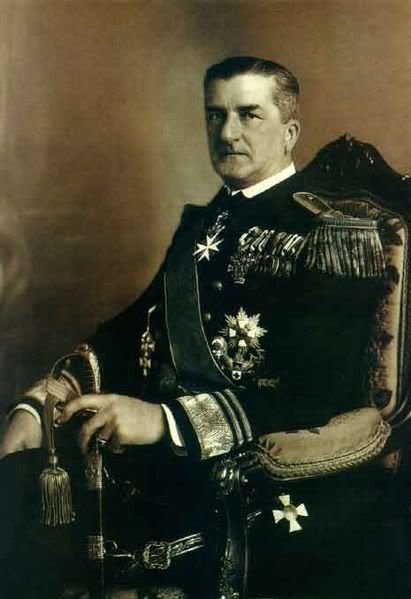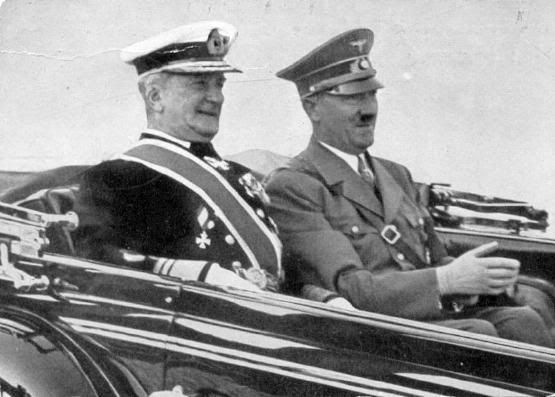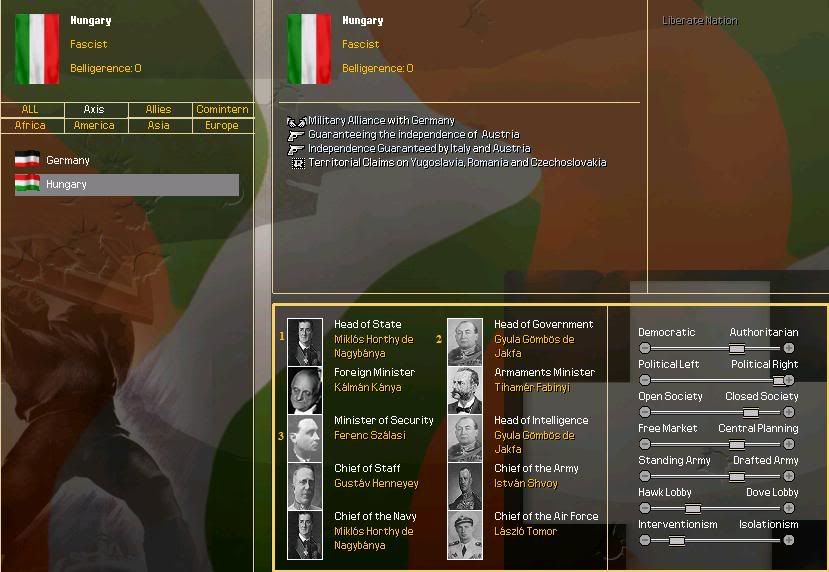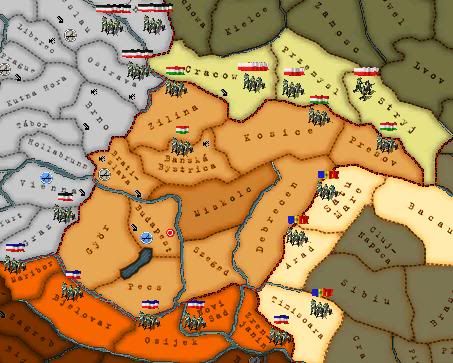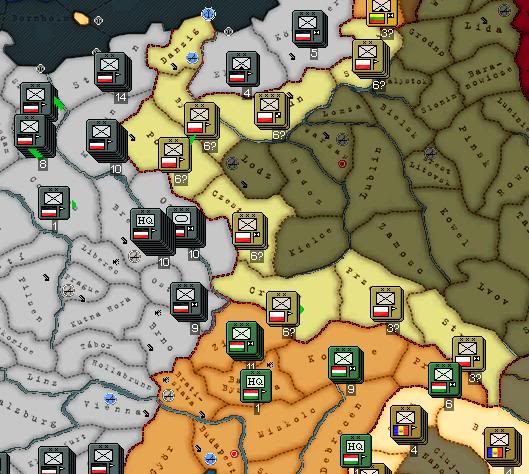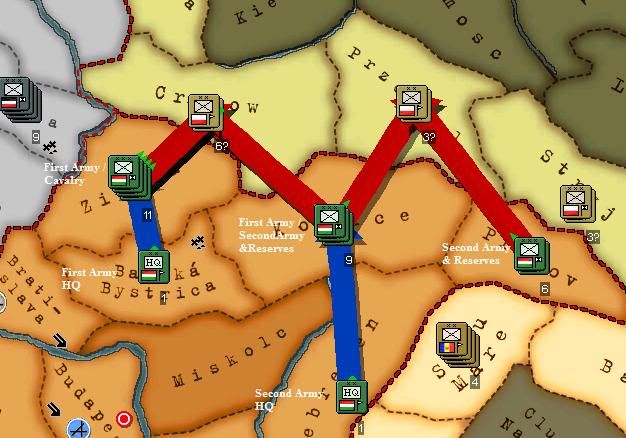Time for the first gameplay update! Starting from the beginning of the game, and covering up through August 1939, right before the war with Poland. This might turn out to be a longer post since it covers almost three years, but subsequent updates will cover shorter spans of time.
Disclaimer: I AM using the money cheat, but only to make it possible to conduct diplomacy -- at almost $80 a shot for influencing nations, there's no way I could work on relationships with other countries with Hungary's meager budget. I won't use the cheat to actually -generate- a cash flow... Just to keep the balance even while I work on diplomacy.
===========
Military Reorganization and the 1936 Draft
Further emboldened by Hungary's standing as Germany's first ally in the Axis, Prime Minister Gombos and his supporters began 1936 by ordering a massive expansion of the Hungarian army. With the army in shreds after World War I, however, a new force would have to be built from the ground up. Without a great standing army to feed from, Gombos instituted a draft in 1936, hoping to raise what would eventually become a permanent, professional Hungarian army.
Assisted by technical specifications and blueprints provided by Germany, Hungary was able to modernize its industrial capabilities to prepare for war-scale production, and to equip its newly-raised divisions with new model rifles, equipment, and artillery guns. Under Gombos' military reform and draft, another 18 new divisions and 10 new brigades would be raised to fight for the kingdom.
The Anti-Comintern Pact
Beginning with the reoccupation of the Rhineland in March of 1936, Germany made a series of increasingly bold moves, both territorially and politically to set the stage for what would become the Second World War. In February of 1937, Germany authored the Anti-Comintern Pact, extending the invitation to Italy and Japan to share information and cooperate in containing the influence of the Soviet Union. Japan, dealing with a direct Soviet border with Manchukuo, readily accepted the German offer of cooperation. Italy, however, chose to back away from the pact, refusing to sign it.
This action soured relations somewhat between Germany and Italy, but it also provided a political opportunity for Hungary. Following Italy's refusal, Hungarian Foreign Minster Kalman Kanya signed the document on Hungary's behalf, taking Italy's place as the third signatory of the pact. Despite the kingdom's relative small size and lack of military strength, Kanya and Gombos hoped that stepping up to embrace the Anti-Comintern Pact would raise Hungary's stature in German eyes, and serve as a first step toward increased support and favor from Germany.
The End of Czechoslovakia and the Beginning of Greater Hungary
In 1938, Hitler succeeded in manipulating Czechoslovakia, successfully forcing the nation to surrender the Sudetenland to German control. Hitler, however, was not content to control merely a portion of western Czechoslovakia; in March of 1939, through a series of clandestine efforts to destabilize the country, he successfully forced the effective surrender and dissolution of the Czech state.
While Tiso would have proved a reliable puppet in a puppet state of Slovakia, Hitler chose instead to grant the eastern portion of Czechoslovakia to Hungary; Bratislava, Zilina, Banska Bystrica, Kosice, and Presov all fell to Hungarian control, nearly doubling the size and industrial output of the kingdom. The First Army was quickly moved from the southern border with Yugoslavia, and redeployed into Hungary's regained lands, manning the border with Poland. Following the partitioning, popular support for the Arrow Cross Party and Hungary's alliance with Germany skyrocketed to an all-time high.
Hungarian soldiers bearing the insignia of the Arrow Cross Party march through Bratislava, just weeks after the partitioning of Czechoslovakia
Hungary following the Czech partition, March 1939
Danzig or War
Throughout 1936-1939, Germany's aggressive territorial expansion had been met with little more than diplomatic rebukes from the Allied Nations, and the expansion of the Third Reich was permitted to run its course. Even when Germany forced Lithuania's hand into surrendering Memel, little real action was taken in response to it.
That would change in August of 1939.
In early August, Germany and the Soviet Union signed the Molotov-Ribbentrop Pact, drawing up the plans for the partitioning of Poland between the two nations, as well as agreeing upon which eastern European countries would be conquered by the Soviets, and which would be left for Germany to occupy. As the Germans applied pressure to Poland to surrender the city of Danzig, the Allies finally took a stand when the United Kingdom guaranteed Poland's full independence in the event of German aggression. On August 30, 1939, Hitler issued the ultimatum to Poland: surrender Danzig, or face war with Germany. Encouraged by the UK's promise of support, Poland defiantly refused Hitler's demands, and invited war against the Axis -- thus began World War II.
German, Hungarian, and Polish forces at the onset of the war
The Invasion of Poland
On the surface, Hungary was the loyal and committed ally, rallying its troops to the Polish border to support Germany in its occupation of Poland, faithfully fulfilling its duties as a member of the Axis. The Hungarian army, which had swelled from 10 divisions in 1936 to 28 divisions at the outbreak of the war, fully mobilized along the border with Poland.
The prevailing mindset in Budapest, though, was that there was a profit to be gained for Hungary in this battle, as well. Directly across the border from Zilina was Poland's second-largest industrial center, in Cracow. Field Marshall Sonyi, commander of the Hungarian First Army, proposed that Hungary take the initiative and occupy Cracow before German soldiers arrived. By claiming Cracow before the Germans, Hungary could then press for the rights to keep it following the occupation of Poland, and its industrial resources could be used to build up the Hungarian army.
Prime Minister Gombos approved, and directed Field Marshall Sonyi to draw up a battle plan for the swift occupation of Cracow.
Field Marshall Sonyi's plan for the Hungarian occupation of Cracow
Under Field Marshall Sonyi's plan, troops from the First Army in Zilina would advance into Cracow, supported by troops from the First and Second Armies in Kosice. The assault in Zilina would also be aided by the Royal Magyar Dragoons, a two-division-strong cavalry force under the leadership of Lt. General Stomm. Ideally, after the initial assault on Cracow succeeded, the fast-moving cavalry would arrive first, claiming the industrial center for Hungary before German troops arrived to continue the attack deeper into Poland. With Cracow secured, troops from Kosice would advance to occupy Przemysl, ensuring that Cracow could not be assaulted from its flanks, and that it would be safely held until the end of the invasion.
Czechoslovakia had only been the first step. Soon, in time, the dream of Greater Hungary would finally be realized.
===========
So there it is! The game's actually rolling, and it's time to fight some Poles. For the randomly interested, here's a little summary of other world events that happened during the first three years.
Yearly Highlights
1936
- Moved slider one step to Standing Army
- February: Japan crushes the 2-26 Coup
- March: Germany reoccupies the Rhineland
- April: Italian annexation of Ethiopia
- July: Spanish Civil War begins, all possible countries except France intervene
- December: Nationalists declare victory in Spanish Civil War
1937
- Moved slider one step to Hawk Lobby
- February: Germany and Japan sign Anti-Comintern Pact, Italy refuses
- June: Japan declares war on China and the unified front
- November: Japan forms puppet state of Mengkukuo
1938
- Moved slider one step to Hawk Lobby
- February: Not too important, but interesting, Japan does not seek German recognition of Manchukuo (never seen them do that before)
- March: Stalin's officer purge, Germany annexes Austria
- September: Germany claims Sudetenland, Japan declares victory over China and creates puppet state
1939
- Moved slider one step to Hawk Lobby
- January: Japan annexes Communist China
- March: Czechoslovakia partitioned between Germany and Hungary; Germany claims Memel; UK guarantees independence of Poland; Italy declares war on Albania
- April: Italy annexes Albania
- August: Germany and Russia sign historical Molotov-Ribbentrop pact; declares war on Poland



